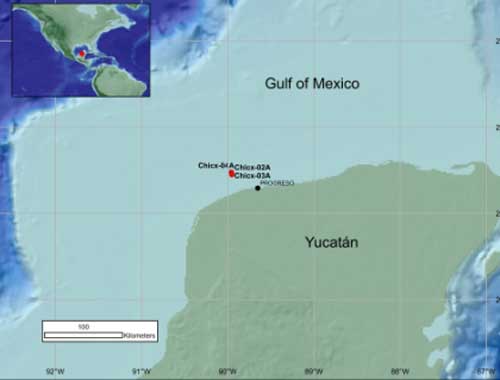International Ocean Discovery Program
2015 - 2016
 Expedition 364 Chicxulub K-Pg Impact Crater
Expedition 364 Chicxulub K-Pg Impact Crater
March 2016 - May 2016
In April and May 2016, EPC was principally involved in IODP Expedition 364: Chicxulub K-Pg Impact Crater, providing downhole logging and core physical properties services, as well as technical support for downhole logging operations.
The ~180 km diameter Chicxulub impact crater sits astride the northern coast of Yucatán, Mexico, and is one of the best preserved large impact crater on Earth. Geophysical surveys across the structure reveal a peak ring associated with low seismic velocities. A peak ring is an inner ring of hills within a crater, they are typically observed in large impact craters and results from the collapse of the central uplift at the time of impact. There are several documented examples from rocky bodies in our solar system, but the Chicxulub impact crater has the best known preserved peak ring on Earth. The aims of IODP Expedition 364 were to better understand:
- What rocks comprise a peak ring and how they are formed;
- How are rocks weakened during large impacts to allow them to collapse into wide, flat craters;
- What caused the environmental changes that led to a mass extinction; and
- What effects do impacts have on the subsurface biosphere and further; can impacts generate habitats for chemosynthetic life?
In order to tackle some of these questions; an IODP MSP expedition utilising the Lift Boat Myrtle was undertaken to investigate this feature at Chicxulub. The expedition successfully drilled a single 1334 m deep hole through the target material, with a 100% recovery rate in the cored interval. Cored material includes post impact carbonate sediments, sampling the PETM and the K-Pg boundaries; post-impact breccia; and the target rocks of the peak ring, consisting mostly of shocked granite and dykes.
The excellent recovery and quality of the material and data collected allowed to address the main scientific objectives, with results published in high impact journal (see below).
Petrophysics Staff Scientist
- Johanna Lofi
Publications
- Morgan, J. V., Gulick, S. P. S., Expedition 364 Scientists (Le Ber, E., Lofi, J.), 2016. The formation of peak rings in large impact craters. Science, 354: 878-882. doi: 10.1126/science.aah6561
- Christeson, G.L., Gulick, S.P.S., Morgan, J.V., Gebhardt, C., Kring, D.A., Le Ber, E., Lofi, J., Nixon, C., Poelchau, M., Rae, A.S.P., Rebolledo-Vieyra, M., 2018. Extraordinary rocks from the peak ring of the Chicxulub impact crater: P-wave velocity, density, and porosity measurements from IODP/ICDP Expedition 364. Earth and Planetary Science Letters, 495, pp.1-11. doi: 10.1016/j.epsl.2018.05.013
- Lofi, J., Smith, D., Delahunty, C., Le Ber, E., Brun, L., Henry, G., Paris, J., Schmitt, D. and the Expedition 364 Scientists, 2018. Drilling and logging related non geological features illustrated from IODP-ICDP Expedition 364 downhole logs and borehole images, Scientific Drilling, 6, 1–13.
- Lowery, C.M., Bralower, T.J., Owens, J.D., Rodríguez-Tovar, F.J., Jones, H., Smit, J., Whalen, M.T., Claeys, P., Farley, K., Gulick, S.P.. Morgan, J.V. and the Expedition 364 Scientists (Lofi, J.), 2018. Rapid recovery of life at ground zero of the end-Cretaceous mass extinction. Nature, p.1. doi: 10.1038/s41586-018-0163-6
- Artemieva, N., Morgan, J. and Expedition 364 Science Party (Lofi, J.), 2017. Quantifying the Release of Climate‐Active Gases by Large Meteorite Impacts With a Case Study of Chicxulub. Geophysical Research Letters, 44(20), pp.10-180. doi: 10.1002/2017GL074879
- Kring, D.A., Claeys, P., Gulick, S.P., Morgan, J.V. and Collins, G.S. and the IODP-ICDP Expedition 364 Science Party (Lofi, J.), 2017. Chicxulub and the exploration of large peak-ring impact craters through scientific drilling. GSA Today. 27, 4-8. doi: 10.1130/GSATG352A.1
- Riller U., Poelchau M., Rae Auriol S.P., Schulte F., Collins G.S., Melosh H.J., Grieve R.A.F, Morgan J.V., Gulick S.S.P., Lofi J., Diaw A., McCall N., Kring D., and IODP-ICDP Expedition 364 Science Party (Le Ber, E.), 2018. Rock fluidization during peak-ring crater formation, Nature, 562, 511–518.
- Urrutia‐Fucugauchi, J., Pérez‐Cruz, L., Morgan, J., Gulick, S., Wittmann, A., Lofi, J. and IODP‐ICDP Expedition 364 Science Party, 2019. Peering inside the peak ring of the Chicxulub Impact Crater—its nature and formation mechanism. Geology Today, 35(2), pp.68-72.
- Lowery, C.M., Morgan, J.V., Gulick, S.P., Bralower, T.J. and Christeson, G.L., and the IODP‐ICDP Expedition 364 Science Party (Lofi, J.), 2019. Ocean Drilling Perspectives on Meteorite Impacts. Oceanography, 32(1), pp.120-134.
- Gulick, S.P., Bralower, T.J., Ormö, J., Hall, B., Grice, K., Schaefer, B., Lyons, S., Freeman, K.H., Morgan, J.V., Artemieva, N., Kaskes, P., and the IODP‐ICDP Expedition 364 Science Party (Lofi, J., Le Ber, E.), 2019. The first day of the Cenozoic. Proceedings of the National Academy of Sciences, 116(39), pp.19342-19351. doi: 10.1073/pnas.1909479116
As Petrophysics Staff Scientist, Johanna Lofi is a co-author on the following expedition-related publications:
Preliminary report
- Gulick S., Morgan J., Mellett C.L., and the Expedition 364 Scientists (Lofi J.), 2017. Expedition 364 Preliminary Report: Chicxulub: Drilling the K-Pg Impact Crater. International Ocean Discovery Program: Preliminary Reports. doi: 10.14379/iodp.pr.364.2017
Expedition proceedings
- Gulick S., Morgan J., Mellett C.L., and the Expedition 364 Scientists (Lofi J.), 2017. Expedition 364 Proceedings: Chicxulub: Drilling the K-Pg Impact Crater.Proceedings of the International Ocean Discovery Program, 364: College Station, TX (International Ocean Discovery Program). doi: 10.14379/iodp.proc.364.2017